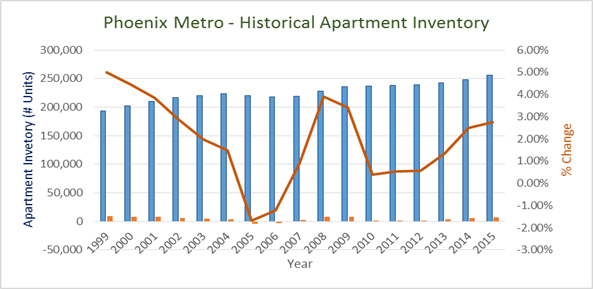Phoenix Metro Apartments: An Investment and Development Viewpoint
March 28, 2016
Joseph Meyer
President & CEO, Meyer Development & Construction Services, Ltd.
Drive around town and you can’t seemingly go more than a mile without encountering another newly completed apartment project – or one that’s under construction. At least that’s the case in the East Valley where distinct pockets of swank new apartments are fetching rents in excess of $2 per square foot – a far cry higher than marketwide average rents that only pierced the $1 per square foot barrier around ten years ago. Contrast this with the dearth of new apartments in the West Valley where only one new apartment deal has been able to get beyond the boards. In the current cycle, demand for new apartments is highly concentrated in a select few submarkets such as Downtown Phoenix, Tempe or Scottsdale. These submarkets are highly attractive to the millennials and baby boomers searching for an urban, high luxury lifestyle.
From a local investment and development standpoint, the current cycle in Phoenix metro is much different than previous cycles where apartment development was more uniformly distributed geographically and in price point. While the supply of new apartment inventory over the past few years is relatively in line with our historical average (see chart below), what makes this cycle different is the concentration of units in a select few submarkets – all with top of the market rental rates.
Worldwide capital markets are seeking higher yields due to collapses in bond yields and commodities. This has forced investors to seek higher returns in alternative investments which has increased investor demand for real estate – particularly in the apartment sector producing record low cap rates. The viability for building new apartments, despite substantially rising land prices and construction costs, has also increased as a result of this shift of investment. The rub is that the few submarkets where new Phoenix metro urban renters want to live are within established infill locations – with higher land cost requiring higher densities. Higher construction costs for items such as parking structures and mid-rise building code requirements have become a common factor for multifamily developers. The higher costs have in turn pushed rental rates to new levels leading developers to focus only in the few select submarkets. Demand is robust enough in these areas where investors can command high rental rates. Conversely, rents in large areas of Phoenix metro, such as in the West Valley where there is an abundant supply of inexpensive single family rental houses, have not increased enough to offset the cost of building new projects.
How long this trend will continue is up for debate. Commercial banks appear to be getting more nervous about the steady supply of new apartments. Maximum construction loan amounts on new projects have been lowered to an average of 60 percent to 70 percent of total project costs – significantly lower than the average 80 percent to 90 percent levels during the mid-2000s. This requires developers to raise more cash equity for new projects and drives down leveraged yields on new deals. Hopefully, self-regulation in the financial markets will prevent a complete overbuild of the apartment sector in the Phoenix metro area – allowing the market to maintain reasonably sound fundamentals going forward.

Source: Cushman & Wakefield
Still, the question that nags at me and other industry veterans is how deep is the market for these new communities charging upwards of $2.00 per square foot rents? We’re beginning to see some new apartment projects in desirable submarkets struggle to get these higher rent levels and maintain a steady lease pace. Industry data aggregator, Real Data’s latest Pipeline Report, shows that there’s roughly 6,800 units currently under construction and another 8,500 on the drawing boards – roughly 6 percent of the current marketwide inventory to come on line over the next three to four years. Continued additions to the market at such high rents will eventually undercut rental rates marketwide leading many of these projects to underperform – and a likely pull back in new apartment construction. Will that pull back come before the market goes completely upside down? Let’s hope so.
It becomes a challenging proposition for the new investor contemplating to participate in this latest wave of apartment housing. Institutional capital is making it very difficult for independent investors to compete for choice apartment sites. However, opportunities still present themselves for value added acquisitions in submarkets where rents are poised for increases. Less posh infill submarkets and smaller sites overlooked by the large developers can offer development opportunities. In addition, underserved niches such as workforce, senior or subsidized housing may become more plausible as this current cycle matures – that is, when we begin to see rents rise equally throughout the Phoenix metro market.
Joseph Meyer is a 27 year veteran in the real estate industry. He is the owner of Meyer Development & Construction Services, Ltd, a real estate development, general contracting and consulting company focused on multifamily and small commercial sectors throughout southwestern United States. Joseph is also a founding partner of Southwest Next Capital Management, Ltd. which currently manages over $135 million real estate investments and funds in Phoenix metro. Joseph can be reached jmeyer@meyerdevco.com or by phone at 602-315-7400.
Residential Leasing Seminar
Friday, April 29, 2016 – 9:00 am to 12:30 pm
A panel of professionals in this market including two prominent attorneys and property management will provide you with valuable information covering the following topics and more:
- Current Market Conditions and Opportunities
- Resolving Tenant-Landord Conflicts
- Latest Legal Lessons of Leasing
- Vacation Rentals
- Upcoming Luxury Apartment Complexes

Tuition: $40
Credit: 3 hrs. Legal Issues


